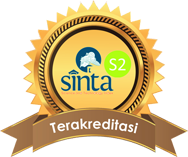Development of Mobile Learning integrated with Learning Management System (LMS) on Buffer Solutions Topic
DOI:
https://doi.org/10.15575/jtk.v6i2.13936Keywords:
LMS, mobile learning, motivation learningAbstract
This research aims to develop mobile learning integrated with LMS and test its effectiveness motivation learning on the topic of buffer solutions. The research was conducted at SMA AL-HASRA from November 2020 to June 2021. The research and development method by Borg and Gall was used by modifying five stages, needs analysis; product development; validation; product testing; and implementation. Testing used quantitative method with post-test only control group design and analysis using independent sample t-test. The resulting mobile learning medium is called "LarutanPenyangga.apk" which is compatible with Android devices which provides summaries, video animations, kimi, quiz, and application buffer solutions in daily life. The feasibility test for topic and language resulted 82.25% with a reliability 0.975. The feasibility test for media 75.05% with a reliability 0.960. Trial test have very good criteria. The effectiveness test of motivation learning percentage is 68.4% and has a good category. Based on the t-test, obtained ttable < tcount. It can be concluded that H0 is rejected and H1 is accepted, which means that there is a significant positive effect from the use of integrated mobile learning with LMS to increase students' learning motivation on buffer solutions topic.
References
Abidah, A., Hidaayatullaah, H. N., Simamora, R. M., Fehabutar. D., & Mutakinati, L. (2020). The Impact of Covid-19 to indonesian education and its relation to the philosophy of “merdeka belajarâ€. Studies in Philosophy of Science and Education (SiPoSE). 1(1). 38-49. https://doi.org/10.46627/sipose.v1i1.9
Abidin, A., Marzal, J., & Rohati, R. (2014). Pengembangan media pembelajaran matematika interaktif berbasis android untuk menumbuhkan motivasi belajar anak disleksia pada materi eksponensial di Kota Jambi. Edumatica: Jurnal Pendidikan Matematika, 4(02). https://doi.org/10.22437/edumatica.v4i02.2072
Adinugroho, T. Y., Reina, & Gautama, J.B. (2015). Review of multi-platform mobile application development using WebView: Learning management system on mobile platform. International Conference on Computer Science and Computational Intelligence (ICCSCI 2015). 291-297. https://doi.org/10.1016/j.procs.2015.07.568
Al-Kindi, S. S., & Al-Suqri, M. N. (2017). Mobilizing learning: Using moodle and online tools via smartphones. International Journal of Knowledge Content Development & Technology, 7(3), 67-86. https://doi.org/10.5865/IJKCT.2017.7.3.067
Ally, M., & Prieto-Blázquez, J. (2014). What is the future of mobile learning in education?. International Journal of Educational Technology in Higher Education, 11(1), 142-151. https://doi.org/10.7238/rusc.v11i1.2033
Antonenko, P. D., Derakhshan, N., & Mendez, J. P. (2013). Pedagogy 2 go: Student and faculty perspectives on the features of mobile learning management systems. International Journal of Mobile Learning and Organisation, 7(3–4), 197–209. Retrieved from https://www.inderscienceonline.com/doi/pdf/10.1504/IJMLO.2013.057161
Apostolov, G., & Milenkova, V. (2018). Mobile learning and digital literacy in the context of university young adults. 14th International Conference Mobile Learning 2018. Retrieved from 105-112. https://files.eric.ed.gov/fulltext/ED590355.pdf
Ardiansyah, A. A., & Nana. (2020). Peran mobile learning sebagai inovasi dalam meningkatkan hasil belajar siswa pada pembelajaran di sekolah. Indonesian Journal of Educational Research and Review. 3(1), 47-56. http://dx.doi.org/10.23887/ijerr.v3i1.24245
Asmara, A. P. (2015). Pengembangan media pembelajaran berbasis audio visual tentang pembuatan koloid. JURNAL ILMIAH DIDAKTIKA: Media Ilmiah Pendidikan dan Pengajaran, 15(2), 156-178. http://dx.doi.org/10.22373/jid.v15i2.578
Barua, P. D., Zhou, X., Gururajan, R., & Chan, K. C. (2018). Determination of factors influencing student engagement using a learning management system in a tertiary setting. In 2018 IEEE/WIC/ACM international conference on Web Intelligence (WI) (pp. 604–609). Santiago, Chile: IEEE. https://doi.org/10.1109/WI.2018.00-30
Biswas, B., Roy, S. K., & Roy, F. (2020). Students perception of mobile learning during Covid-19 in Bangladesh: University student perspective. Aquademia, 4(2), ep20023. Retrieved from https://papers.ssrn.com/sol3/papers.cfm?abstract_id=3667908
Black, E. W., Dawson, K., & Priem, J. (2008). Data for free: Using LMS activity logs to measure community in online courses. The Internet and Higher Education, 11(2), 65–70. https://doi.org/10.1016/j.iheduc.2008.03.002
Boumová, V. (2008). Traditional vs. Modern Teaching Methods: Advantages and Disadvantages of Each. Ceko: Masaryk University Faculty of Arts. https://is.muni.cz/th/86952/ff_m_b1/mgrdiplomkaboumova.pdf
Bunce, D. M. (2009). Teaching is more than lecturing and learning is more than memorizing: 2007 james flack norris award. Journal of Chemical Education, 86(6), 674–680. https://doi.org/10.1021/ed086p674
Cavus, N., Uzunboylu, H., & Ibrahim, D. (2007). Assessing the success rate of students using a learning management system together with a collaborative tool in web-based teaching of programming languages. Journal of Educational Computing Research, 36(3), 301–321. https://doi.org/10.2190/T728-G676-4N18-6871
Chung, C. H., Pasquini, L. A., & Koh, C. E. (2013). Web-based learning management system considerations for higher education. Learning and Performance Quarterly, 1(4), 24-37. Retrieved from https://www.researchgate.net/publication/235956447_Web-based_Learning_Management_System_Considerations_for_Higher_Education
Hanafi, Y., Murtadho, N., Ikhsan, M. A., & Diyana, T. N. (2020). Reinforcing public university student’s worship education by developing and implementing mobilelearning management system in the ADDIE instructional design model. International Journal of Interactive Mobile Technologies (iJIM). 14(2). Retrieved from https://www.researchgate.net/publication/339151162_Reinforcing_Public_University_Student%27s_Worship_Education_by_Developing_and_Implementing_Mobile-Learning_Management_System_in_the_ADDIE_Instructional_Design_Model
Herliandry, L. D., Nurhasanah, Suban, M. E., Kuswanto, H. (2020). Pembelajaran pada masa pandemi Covid-19. Jurnal Teknologi Pendidikan. 22(1). 65-70. https://doi.org/10.21009/jtp.v22i1.15286
Horvat, A., Dobrota, M., Krsmanovic, M., & Cudanov, M. (2015). Student perception of Moodle learning management system: A satisfaction and significance analysis. Interactive Learning Environments, 23(4), 515–527. https://doi.org/10.1080/10494820.2013.788033
Hu, X., Ng, J., Tsang, K. K., & Chu, S. K. (2019). Integrating Mobile Learning to Learning Management System in Community College. Community College Journal of Research and Practice, 44(10-12), 722-737. https://doi.org/10.1080/10668926.2019.1640146
Hung, P., Lam, J., Wong, C., & Chan, T. (2015). A study on using learning management system with mobile app. International Symposium on Educational Technology (ISET), 168-172). IEEE. https://doi.org/10.1109/ISET.2015.41
Kemendikbud. (2020). Ministry of Education and Culture No. 4 & 15 2020. Jakarta: Kemendikbud
Kukulska-Hulme, A. (2012). Smart devices or people? a mobile learning quandary. International Journal of Learning and Media. 4(3-4), 73-77. https://doi.org/10.1162/IJLM_a_00105
Laila, K. N., Martin HB, F. P., & Irsadi, A. (2016). Efektifitas media pembelajaran androplantae berbasis android pada materi dunia tumbuhan untuk siswa SMA. Unnes Journal of Biology Education. 5(2), 110-115. Retrieved from https://journal.unnes.ac.id/sju/index.php/ujbe/article/view/14651
Lestari, I., Maksum A., & Kustandi C. (2019). Mobile learning design models for state university of Jakarta, Indonesia. International Journal of Interactive Mobile Technologies (Ijim). 13(9). 152-171. https://doi.org/10.3991/ijim.v13i09.10987
Lonn, S., & Teasley, S. D. (2009). Saving time or innovating practice: Investigating perceptions and uses of learning management systems. Computers & education, 53(3), 686-694. https://doi.org/10.1016/j.compedu.2009.04.008
Martin, F., & Ertzberger, J. (2013). Here and now mobile learning: An experimental study on the use of mobile technology. Computers and Education, 68, 76–85. https://doi.org/10.1016/j.compedu.2013.04.021
Naciri, A., Baba, M. A., Achbani, A., & Kharbach, A. (2020). Mobile Learning in Higher Education: Unavoidable Alternative during COVID-19. Aquademia, 4(1), ep20016. https://doi.org/10.29333/aquademia/8227
Ouadoud, M., Nejjari, A., Chkouri, M. Y., & El-Kadiri, K. E. (2017). Learning management system and the underlying learning theories: In Proceedings of the Mediterranean Symposium on Smart City Applications (732-744). Springer, Cham. https://doi.org/10.1007/978-3-319-74500-8_67
Ozdamli, F., & Cavus, N. (2011). Basic elements and characteristics of mobile learning. Procedia-Social and Behavioral Sciences, 28, 937– 942. https://doi.org/10.1016/j.sbspro.2011.11.173
Penciner, R. (2013). Does powerpoint enhance learning? Canadian Journal of Emergency Medicine, 15(2), 109 – 112. https://doi.org/10.2310/8000.2013.130756
Setiawati, N., Kartika, I., & Purwanto, J. (2012). Pengembangan mobile learning (m-learning) berbasis moodle sebagai daya dukung pembelajaran fisika di SMA. In Prociding: Seminar Nasional Fisika dan Pendidikan Fisika, 3(3), 178–186. Retrieved from https://www.academia.edu/download/44978690/penelitian_relevan_1.pdf
Sicat, A. S. (2015). Enhancing college students’ proficiency in business writing via schoology. International Journal of Education and Research. 3(1), 159-178. Retrieved from https://www.ijern.com/journal/2015/January-2015/14.pdf
Silin, Y., & Kwok, D. (2017). A study of students’ attitudes towards using ict in a social constructivist environment. Australasian Journal of Educational Technology, 33(5), 50–62. https://doi.org/10.14742/ajet.2890
Yektyastuti, R., & Ikhsan, J. (2016). Pengembangan media pembelajaran berbasis android pada materi kelarutan untuk meningkatkan performa akademik peserta didik SMA. Jurnal Inovasi Pendidikan IPA. 2 (1). 88-99. https://doi.org/10.21831/jipi.v2i1.10289
Zydney, J. M., & Warner, Z. (2016). Mobile apps for science learning: Review of research. Computers & Education 94, 1-17. https://doi.org/10.1016/j.compedu.2015.11.001
Downloads
Published
How to Cite
Issue
Section
Citation Check
License
Authors who publish with this journal agree to the following terms:
- Authors retain copyright and grant the journal right of first publication with the work simultaneously licensed under a Creative Commons Attribution-ShareAlike that allows others to share the work with an acknowledgement of the work's authorship and initial publication in this journal.
- Authors are able to enter into separate, additional contractual arrangements for the non-exclusive distribution of the journal's published version of the work (e.g., post it to an institutional repository or publish it in a book), with an acknowledgement of its initial publication in this journal.
- Authors are permitted and encouraged to post their work online (e.g., in institutional repositories or on their website) prior to and during the submission process, as it can lead to productive exchanges, as well as earlier and greater citation of published work (See The Effect of Open Access).








